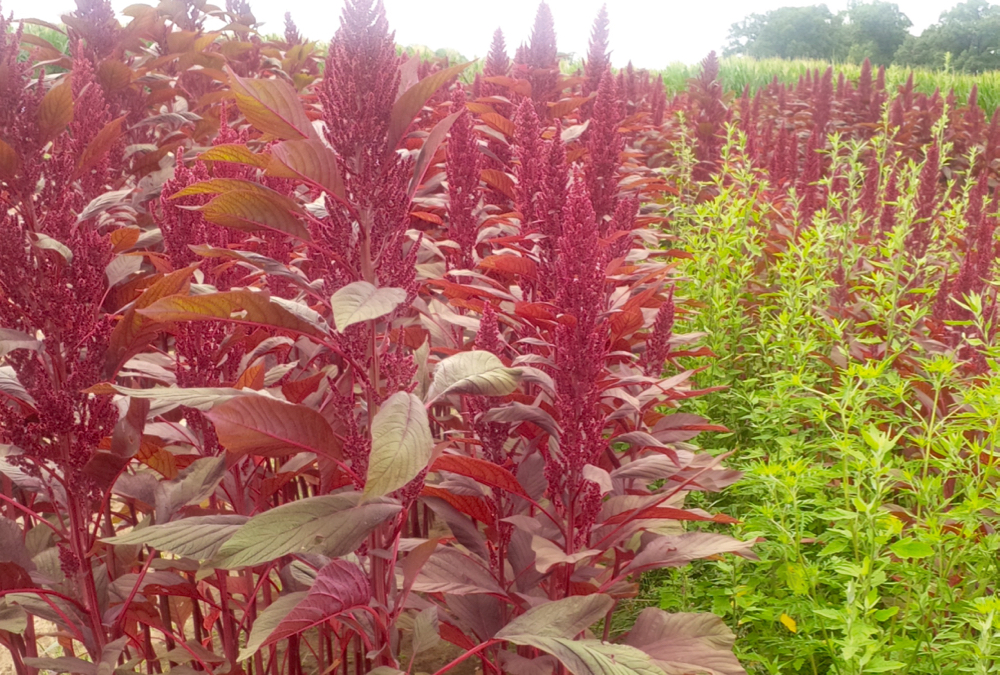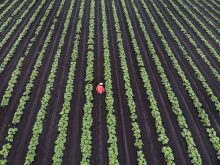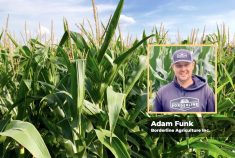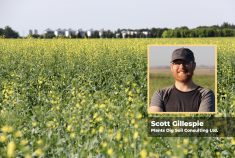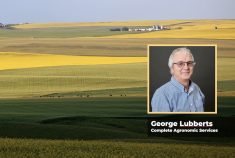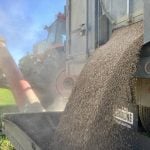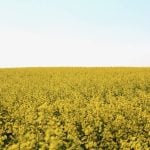It’s a healthy, high-protein crop option, and some growers in Western Canada have already given quinoa a try, in part because it helps break blackleg and sclerotinia disease cycles in canola.
Though while well suited to the Prairie climate, which is similar to its ancestral home in the Andes of South America, hot summer days at flowering can spell disaster for yield. But those interested in giving it a try can find information from research trials and companies contracting the crop.
Quinoa likes sandy loam soil and no special planting equipment is needed, says Lane Christiansen, farm services representative for NorQuin, based in Saskatoon. He says it’s typically seeded at 5 to 10 C (10 C is optimal) from May 5 to the last week of May.
Read Also

Sensing the soil: Root cell research finds ‘stress hormone’
Research into how root cells react to soil stressors could help plants better adapt to changes in their climate.
“Early planting will help to reduce early-season weed pressure and lessen the risk of sterilization due to heat later during the growing season … the aim is that flowering would occur earlier, during lower temperatures,” says James Frey, applied research specialist at Manitoba Agriculture’s Parkland Crop Diversification Foundation, which has been trialing five to seven varieties annually for 10 years. “It also avoids, as possible, insect pressure during the early stages of plant development.”
Prairie Quinoa in Portage la Prairie, Man.,has supplied the seven varieties for the trials. Founder and chief operations officer Percy Phillips, who’s grown the crop since 2012, says quinoa has been grown successfully in Manitoba from the U.S. border to Swan River in the north.
NorQuin’s Christiansen says its four varieties (gold, white, red and black) grow well in all areas but have different maturities of from 95 to 120 days. Quinoa responds well to nitrogen, and fertility needs are similar to wheat.
Frey says that while quinoa tolerates cool weather, it will be damaged by a hard frost, so while an earlier seeding date is ideal, producers should also watch the long-term forecast and avoid seeding before a hard frost.
Weed and pest control
Insect pressure is the same or higher for quinoa than it is for canola. Some of the most challenging insect pests for this crop include stem borer (which will eat out the pithy interior of the stem, reducing yield or even killing the plant outright), goosefoot groundling moth (which attacks the developing seed head), lygus bug (which sucks sap from the plant), and bertha armyworm (which eats the foliage). Frequent field scouting is required to avoid potentially major yield losses.
“Further, producers should closely monitor field activities in adjacent crops,” says Frey. “For example, mid-season hay cutting in neighbouring fields can result in a huge number of hungry lygus bugs that will relocate to the quinoa field.”
Frey advises growers to consult with the contractor or an agronomist about how best to deal with insect pressure.
Regarding insecticides with Minor Use registration, Christiansen says that “currently, Closer is registered for quinoa and Coragen has URMULE registration (new use added to an existing label.) We are expecting another insecticide and another two fungicides being available for next season.”
He adds that minor use registration for Group 1 herbicides was expected in 2020, but approval was delayed by the pandemic and is now expected for the 2022 season. Overall, because it’s so closely related to lamb’s quarters, only grassy weeds can be sprayed within a quinoa crop and most broadleaf herbicides will damage the plants.
Broadleaf weed control is important in quinoa. Christiansen says to pick your cleanest fields. “Many growers do a fall harrow and another heavy harrow in the spring to entice weed germination and get a stronger burn-down. What’s good is that quinoa has a fast establishment and it can establish ahead of weeds and outcompete weeds during the season.”
Controlling volunteers
There are some preliminary insights about weeds from a three-year study on introducing high-value specialty crops at Farming Smarter in Lethbridge, led by Jan Slaski at InnoTech Alberta.
Farming Smarter research co-ordinator Michael Gretzinger says high weed pressure was the major issue for quinoa, in some cases causing complete crop failure.
“Quinoa after canola had too many volunteers, and canola seed is so close it’s really hard to clean from the samples. As a general rule, quinoa growers in our area are very selective about field history. The usual choice is cereal stubble because it’s easy to keep weed-free in years prior.”
He adds that growers should try to time seeding with a good shot of moisture and spraying or cultivating a flush of weeds to give the crop its best start.
Quinoa is susceptible to downy mildew and phoma stalk rot, but Christiansen points out that environmental conditions have to be right for diseases to form.

Harvest
Frey says that depending on the variety, quinoa may retain high moisture in the stem and seed head well into maturity. Longer-maturing varieties may be swathed to assist in dry-down, or a desiccant may be used. Combine settings should include medium thresher speed and medium-high wind speed to discharge chaff and dust.
NorQuin’s contracted quinoa must be straight cut to prevent sprouting and to get the highest grade.
Their varieties produce average yields of 1,000 pounds or 25 bushels per acre in dryland fields and at least double that in irrigated fields. About 30 per cent of NorQuin’s acreage is irrigated and Christiansen says the firm is looking to increase irrigated acres in all Prairie provinces in 2022.
In addition, its breeders are working on new varieties with higher yield, better disease tolerance and higher protein, along with lower saponins in the outer shell, which means less cleaning will be needed.
Contracts and delivery
NorQuin contracts 30 to 50 growers a year for a minimum of 80 acres, and applications are accepted every fall and winter until contracting is full. Up to 30,000 acres are under company contract each year. Prairie Quinoa also contracts “a limited amount” of growers.
Christiansen says quinoa generally fetches an increased price over canola in most years.
Markets and prices
Manitoba’s Prairie Quinoa markets its “Amber Quinoa” directly in local farmers markets and at provincial Sobey’s stores.
NorQuin products are sold in major Canadian grocery chains, co-ops and independents. The firm also exports to the U.S., Mexico, South America, Europe, Australia, Korea and Japan.
“We also sell into the ingredient markets in the form of flour, flakes and pops, and we also partnered with Ingredion in 2020, a global ingredient-maker,” explains Christiansen. “Demand has been very good and we expect it to grow with the growing interest in plant-based protein products.”
Their low-grade grain goes into pet food and Christiansen says quinoa may be approved for livestock feed in Canada in the future. Organic production is a future possibility.
Frey says that potential growers should do their homework before planting.
“Talk, if possible, with other growers in your area to learn from their experience. Quinoa can be a valuable addition to a crop rotation, but can also present some major challenges, especially with regards to insects.”



